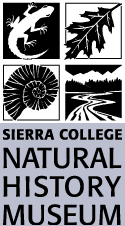2012 Lectures
January 27Forests of North America
Joe Medeiros
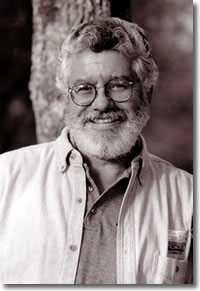 Often misunderstood as being simply large collections of only trees, forests are complex associations of plants, animals, fungi, and invertebrates that evolve together in dynamic equilibrium. Referred to as “lungs of the world” these tree-dominated terrestrial ecosystems provide much more in environmental services than simply oxygen and the sequestration of carbon dioxide.
Often misunderstood as being simply large collections of only trees, forests are complex associations of plants, animals, fungi, and invertebrates that evolve together in dynamic equilibrium. Referred to as “lungs of the world” these tree-dominated terrestrial ecosystems provide much more in environmental services than simply oxygen and the sequestration of carbon dioxide.
Join Sierra College Professor Emeritus of biology Joe Medeiros in a slide-illustrated tour of North American Forests. We’ll have a look at the major species that inhabit forests from the steamy cypress swamps of the southern bayous to the northern boreal forests of America. Important issues such as deforestation, fire ecology and climate change will be included as we speculate on the future of these critically important biomes.
Joe Medeiros taught college botany and ecology for 33 years. He was a National Park Ranger and has traveled around the world to study mountain forests and alpine ecosystems.
February 24California Rangeland Conservation Coalition
Ed Pandolfino and Tracy Schohr
Join ornithologist Ed Pandolfino and rangeland conservationist Tracy Schohr to hear about the science that illustrates the multiple public benefits we receive from rangelands. They will discuss activities of various partners in the California Rangeland Conservation Coalition and share stories of ranching families who are stewards of California’s wide open spaces.
Ed Pandolfino is Conservation Chair of the Sierra Foothills Audubon Society and Vice President of the Western Field Ornithologists. Since retiring, he has devoted his time to birding and bird-related conservation and research. Tracy Schohr is a Director of the Rangeland Coalition where she coordinates partnership activities, advises research projects and manages outreach initiatives.
March 23Pikas of the Northern Sierra
David Wright
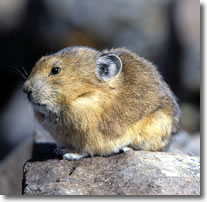 Dr. David Wright and Joseph Stewart of the California Department of Fish and Game have been peering into rock crevices in the northern Sierra Nevada and beyond to see whether the American pika may be affected by climate change. Arguably the cutest animal in the state, the pika lives at high elevations and is thought to be sensitive to warming. As with a lot of science, their study has been raising many new questions.
Dr. David Wright and Joseph Stewart of the California Department of Fish and Game have been peering into rock crevices in the northern Sierra Nevada and beyond to see whether the American pika may be affected by climate change. Arguably the cutest animal in the state, the pika lives at high elevations and is thought to be sensitive to warming. As with a lot of science, their study has been raising many new questions.
David Wright is a wildlife biologist with the Department of Fish & Game’s North Central Region. He works on a variety of projects, including Bank Swallows and Yellow-billed Cuckoos along the Sacramento River, Swainson's Hawk nest monitoring in the Sacramento Valley, habitat linkages, wolverines and other medium-sized forest carnivores, and climate-change effects on wildlife and habitats in the Sierra Nevada.
April 20The Tramp and the Roughrider: John Muir and Teddy Roosevelt
Lee Stetson and Alan Sutterfield
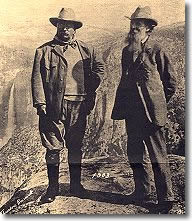 Back by popular demand is this lively reenactment of the famous 1903 meeting of President Theodore Roosevelt and California naturalist, John Muir.
Returning to Sierra College for his annual "Muir visit" during Earth Day week, Lee will bring Teddy (Alan Sutterfield) along and perform this popular historical play (written and directed by Lee Stetson).
Back by popular demand is this lively reenactment of the famous 1903 meeting of President Theodore Roosevelt and California naturalist, John Muir.
Returning to Sierra College for his annual "Muir visit" during Earth Day week, Lee will bring Teddy (Alan Sutterfield) along and perform this popular historical play (written and directed by Lee Stetson).
In May of 1903 President Theodore Roosevelt invited naturalist John Muir to join him on a four-day camping trip in the Yosemite wilderness. The Tramp and the Roughrider illuminates this extraordinary encounter, with the action unfolding at sunset on Glacier Point, overlooking magnificent Yosemite Valley. Both characters were feisty and opinionated. The had sharp disagreements on issues like hunting, animal rights and forest management. Muir’s poetic and evangelistic temperament, clashing with Roosevelt’s political and boyish enthusiasms, naturally spawned both tension and humor.
Both skillful storytellers, it seems natural that both would seek to top one another by relating some of their many adventures in the American wilderness—Roosevelt bring a frontier ruffian to justice, for example, or Muir telling of his hair-raising “interview” with a Yosemite bear. At the time of this historic meeting, many millions of acres of our western forests, with little or no governmental supervision, were being exploited and abused by hunting, lumbering, grazing, and mining interests. But around the campfire, sifting through their histories and their hopes, these very different men slowly discovered how the other had been shaped by the wilderness they both loved – opening up some rich possibilities for “doing some forest good.”
Join professional actors Lee Stetson and Alan Butterfield for this rare performance, commemorating this historically significant event in American history.
May 11Hiking the Pacific Crest Trail
Robert Francisco
In 2006 biologist and environmental consultant Robert Francisco left his corporate office and embarked on a five month trek across the western United States along the Pacific Crest National Scenic Trail (PCT). Through drought stricken southern California deserts, the snow covered Sierra Nevada, blistering hot Oregon lava fields, and the early blizzards of the northern Cascades, please join us as Robert presents a photo journey of this epic trip.
August 31Crazy About Mushrooms: Conversations with Mushroom Fanatics
by Anna McHugh
 What do the poisoned Emperor Claudius, the Aztec storm deity Quetzalcoatl and a 5,500 year-old Ice Man have in common? They were all crazy about mushrooms! "Crazy About Mushrooms" is a dynamic, multimedia presentation that brings the story of the mysterious mushroom to light.
What do the poisoned Emperor Claudius, the Aztec storm deity Quetzalcoatl and a 5,500 year-old Ice Man have in common? They were all crazy about mushrooms! "Crazy About Mushrooms" is a dynamic, multimedia presentation that brings the story of the mysterious mushroom to light.
Anna McHugh is an award-winning journalist, writer and mushroom lover from Nevada City, CA. In 2011, Anna produced a documentary about mushrooms and the people who love them for the Corporation for Public Broadcasting. From tales of Russian mobsters trying to corner the morel market to discussions of how to use fungi to remediate contaminated coastlines, Anna's archive of interviews breathes life into the science and enchantment of mycology. Using a blend of recordings, images and scientific storytelling, Anna illustrates how a passion for mushrooms transforms our relationship to the planet.
September 28Night Wings: Bats of Western North America
by George Baumgardner
 There are 20 to 30 species of bats known to live in Western North America. Some of these animals weigh as little as a nickel and yet can live over 30 years. Most of these bats eat flying insects but some live on pollen and nectar, and one even feeds on scorpions. Come hear other interesting tales about these fascinating creatures from George D. Baumgardner, Curator of Natural History at the Nevada State Museum in Carson City, NV.
There are 20 to 30 species of bats known to live in Western North America. Some of these animals weigh as little as a nickel and yet can live over 30 years. Most of these bats eat flying insects but some live on pollen and nectar, and one even feeds on scorpions. Come hear other interesting tales about these fascinating creatures from George D. Baumgardner, Curator of Natural History at the Nevada State Museum in Carson City, NV.
Dr. George Baumgardner has conducted research on mammals, amphibians, and reptiles for 35 years in Tennessee, the southwestern United States, and Mexico. He has years of experience working in biological collections and museums, including positions at Texas A&M University’s Department of Wildlife & Fisheries Sciences and the Texas Memorial Museum at the University of Texas at Austin. He is now the Curator of Natural History at the Nevada State Museum where he oversees the museum’s collections of biological and geological specimens and assists in the preparation of exhibits and educational programming on these subjects.
October 26How the Sierra Obtained its Beauty
by Professor Dick Hilton
Dick Hilton, a geologist with the Sierra College Earth Sciences Department, will present a lecture that discusses the rise and fall of world glaciers with a special emphasis on California and the Sierra Nevada. Dick Hilton is a Professor of Geology and Paleontology at Sierra College. He has a Bachelor’s degree in Geology with a minor in Biology, and a Master’s degree in Earth Science from California State University, Chico.
Hilton is a paleontological consultant and an avid nature photographer. He is Chairman of the Sierra College Natural History Museum, and a board member of the California State University Chico, Geoscience Board, and the Northern California Natural History Museum. He has published numerous scientific articles in the field of vertebrate paleontology and a book entitled, Dinosaurs and other Mesozoic Reptiles of California (University of California Press, 2003.).
October 27California Glaciers
by Tim Palmer
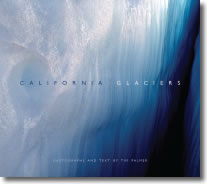 Tim Palmer, an award-winning author and photographer, will present “California Glaciers,” based on his newest book co-published by the Sierra College Press and Heyday Books. Tim Palmer has written twenty-two books about the American landscape, conservation, adventure travel, and rivers. California Wild, a text and photographic book, won the Benjamin Franklin Award for the best book on nature and the environment in 2004. Palmer wrote the text for the Yosemite Association’s Yosemite: The Promise of Wildness, which received the Director’s Award from the National Park Service as the best book of the year in 1997.
Tim Palmer, an award-winning author and photographer, will present “California Glaciers,” based on his newest book co-published by the Sierra College Press and Heyday Books. Tim Palmer has written twenty-two books about the American landscape, conservation, adventure travel, and rivers. California Wild, a text and photographic book, won the Benjamin Franklin Award for the best book on nature and the environment in 2004. Palmer wrote the text for the Yosemite Association’s Yosemite: The Promise of Wildness, which received the Director’s Award from the National Park Service as the best book of the year in 1997.
His other books include, Rivers of America, which features 200 color photos of rivers nationwide, Rivers of California, and Luminous Mountains, published by Heyday in collaboration with the Yosemite Association. Palmer has traveled extensively through the mountains of California by foot and on skis, with his canoe and whitewater raft, and in his well-equipped van.
November 30Perspectives on Managing and Conserving California's Native Trout Species
by Jeff Weaver
 Join us for an overview of DFG’s Heritage and Wild Trout Program from Jeff Weaver, a scientist with the Department of Fish & Game, as he discusses current management and conservation actions being taken for native trout species. Jeff will describe lessons learned from the meeting room and the field, his experiences with native trout and their habitats, the efforts we are putting forth to conserve trout both for their ecological values and for the enjoyment and appreciation of future generations, as well as the challenges we face to accomplish these ends. Jeff Weaver has been engaged in the field of biological conservation and natural resource protection and management for the past 20 years. His career began as an undergraduate performing seasonal fisheries field work with the California Department of Fish and Game.
Join us for an overview of DFG’s Heritage and Wild Trout Program from Jeff Weaver, a scientist with the Department of Fish & Game, as he discusses current management and conservation actions being taken for native trout species. Jeff will describe lessons learned from the meeting room and the field, his experiences with native trout and their habitats, the efforts we are putting forth to conserve trout both for their ecological values and for the enjoyment and appreciation of future generations, as well as the challenges we face to accomplish these ends. Jeff Weaver has been engaged in the field of biological conservation and natural resource protection and management for the past 20 years. His career began as an undergraduate performing seasonal fisheries field work with the California Department of Fish and Game.
After graduating from CSU Sacramento, he worked for the US Forest Service as a Wilderness Ranger and Wilderness Program Manager in Desolation Wilderness, and spent winter months teaching sixth grade outdoor education at the Sly Park Environmental Education Center. While in graduate school, he spent summers performing remote, backpack based, biological field surveys across the Sierra Nevada Mountains to document the presence (or absence) and abundance of native amphibians (mountain yellow-legged frogs, Yosemite toads and other taxa) and then took a permanent position with CDFG as a CalFED Ecosystem Restoration Program grant manager in the northern Sacramento Valley area.
In 2006, he transferred to the CDFG Heritage and Wild Trout Program, where he is currently a Staff Environmental Scientist, focusing on statewide native trout conservation and management. He also teaches occasional Natural History Field Studies courses through Folsom Lake College, with a focus on Sierra Nevada ecosystems and biotic communities.
